The HTC One (M8) Review
by Anand Lal Shimpi & Joshua Ho on March 26, 2014 7:00 PM EST- Posted in
- Smartphones
- HTC
- Mobile
- HTC One
Battery Life
The new One features an integrated 3.8V 2600mAh battery (9.88 Wh), a 13% increase in capacity compared to the previous model. The battery comparison isn’t that simple however. The M8 has a larger display (5” vs 4.7”) but it also has a higher performing and more power efficient SoC (Snapdragon 801 vs. 600). To find out how the new One stacks up against its predecessor, we turn to a mix of old and new battery life tests to help better characterize the device.
We’ll start with our standard browser based battery life tests. Keep in mind here these tests are as much about replicating a particular CPU profile as they are about loading specific web pages in order.
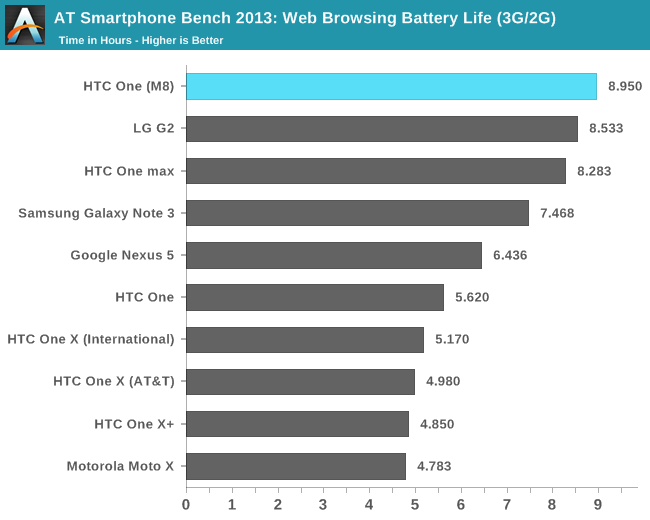
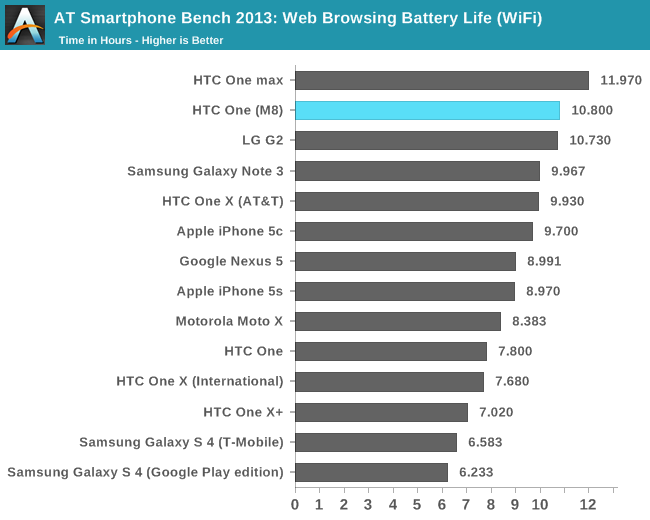
We saw a substantial gain in battery life with Snapdragon 800, and 801 extends that even further. For the same, relatively light (yet constant) workload, the M8 improves battery life over the M7 by as much as 71%. On WiFi the advantage drops to only 38%, but we’re still talking about absolutely huge generational gains.
A constant workload is only one part of the story though. More often than not, when you’re faced with faster compute you end up doing more. To see what the other extreme of battery life looks like I turned to two canned tests: BaseMark OS II and GFXBench 3.0.
I ran both of these tests under the same controlled conditions we always use, with all displays calibrated to 200 nits. BaseMark OS II runs through a bunch of CPU and storage benchmarks (basically the same tests used for the BaseMark OS II system and memory tests), as fast as possible, until the battery dies.
I like this benchmark as it gives us an indication of worst case battery life if you’re absolutely hammering the CPU (and storage) relentlessly.
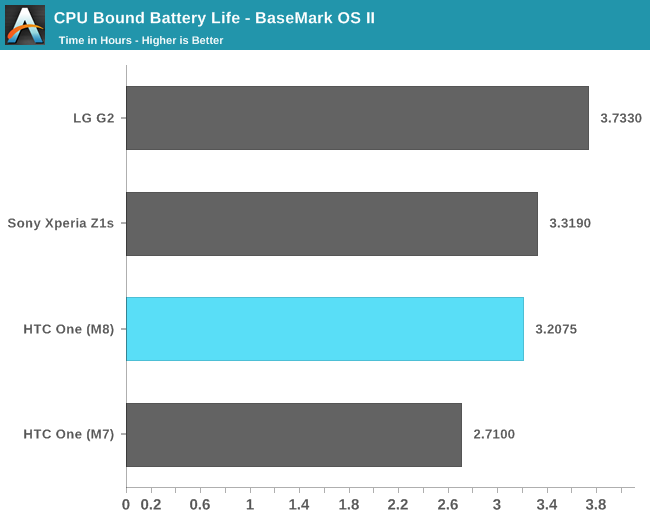
Despite the faster CPU cores, the M8’s battery life actually goes up compared to M7. Here we’re really seeing the benefits of 801’s updated 28nm HPm process compared to the Snapdragon 600’s 28nm LP process.
GFXBench provides a similar test, with effectively uncapped performance (on today’s devices at least since we’re not hitting v-sync limits), but stressing the GPU instead of the CPU. Here we’re running the T-Rex HD benchmark, onscreen, until the battery dies.

This is the first and only test we’ve got here that shows a regression in battery life compared to M7. The M8 loses about 6% of runtime compared to the M7, despite having a larger battery. Now look at what happens if we look at performance at the end of the run:
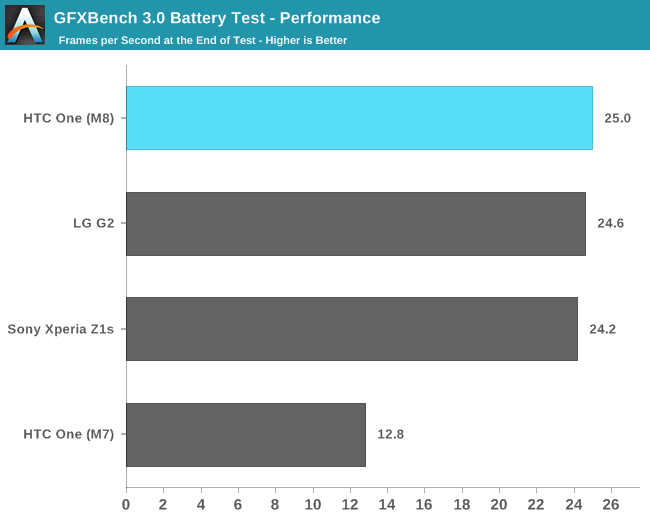
Now the M8’s battery life regression doesn’t look so bad. You give up 6% of runtime but you get almost twice the performance compared to M7. Snapdragon 801 is just a huge upgrade compared to 600.
Charge Time
The M8 features a Qualcomm Quick Charge 2.0 enabled PMIC, which enables faster battery charge times through higher voltage charging. Unfortunately the in-box wall adapter is only Quick Charge 1.5 compliant so you'll only pull 7.5W from the wall. HTC expects to offer a Quick Charge 2.0 compliant power adapter later this year.
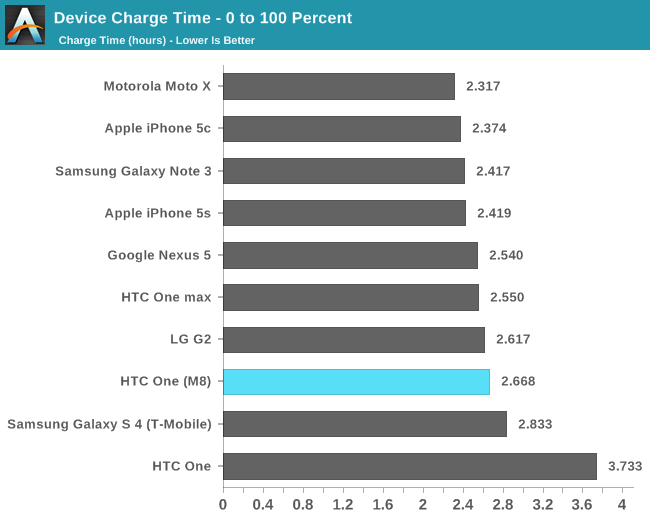
The M8's charge time is a bit slow compared to what we've seen from other devices with larger batteries.










222 Comments
View All Comments
Mugur - Friday, March 28, 2014 - link
What I hate about the onscreen buttons is when you are using the phone in landscape mode and they take a lot of real estate of the screen... So I think I will stay another year with my "old" One (M7) - unless they cannot replace/repair under warranty my broken focus of the camera...martinpetrov1568 - Thursday, March 27, 2014 - link
Anand u say it is difficult and takes multiple exposures to create a photo such as the duo camera, but it is not. A normal photo with no blur from the depth of field simply needs a gaussian blur filter along with a soft brush in photoshop. I can do it, along with anyone else in this planet in 3 minutes tops. I'm sure there is a mobile application for this toosevenmack - Thursday, March 27, 2014 - link
But most people don't have Photoshop, Martin, and many of the photo apps out there focus on other kinds of filter (including ones that change colors) instead of Gaussian blur. So Anand is correct that it can be hard for the average person without graphic design software to do.NesuD - Thursday, March 27, 2014 - link
Double tap will put the screen back to sleep but only when the phone is in a locked state.NesuD - Thursday, March 27, 2014 - link
Been using mine for a day and a half now and everything about it has impressed me so far.djw39 - Thursday, March 27, 2014 - link
Reading this review on chrome for Android and the aspect ratio of the still pictures is offwillis936 - Thursday, March 27, 2014 - link
It looks quite nice but aside from the bump in screen size, battery and CPU I don't see much in the way of improvements. There are small things like faster radios and of course everything software related and that rather interesting dual camera trick, but for the most part it's just the generational gimmicks. All of this is well and good but the unnoticed significant regression in display quality and loss of OIS is crucial. OIS in particular. That's one of the best things you can put on a phone camera and just disappeared from the nicest looking android.marcn404 - Thursday, March 27, 2014 - link
Using a pair of stereo images, a depth map can be created. UFocus probably uses this depth map to blur part of an image which is at a certain depth. That's why in the picture above, the table is in focus as well as the main subject, since both are at the same depth. That's how it should be with a real camera, so this shouldn't be regarded as a limitation.ccd2 - Thursday, March 27, 2014 - link
My best guess is that the market is going to move away from "kitchen sink" phones like the S5 or even this phone. I think market, particularly for premium phones, will start to break into niches. Some people like larger phones, others may place a premium on the camera, still others may want a business orientation to their phone or want the phone to emphasize entertainment. As an example, as a Note 3 owner, I could care less about the S5. But this is my second Note phone and am leaning towards getting another Note when the time comes.chang3d - Thursday, March 27, 2014 - link
Your cellular band support chart on the front page for Sprint is missing some information. Sprint's model does support the same GSM/WCDMA bands that the Verizon model has.